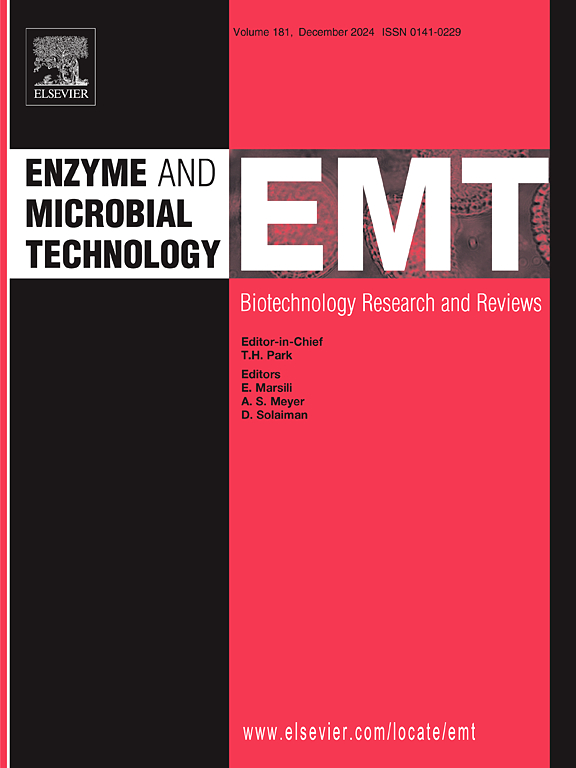壳聚糖、海藻酸钙和硅胶固定化真菌酪氨酸酶以去除苯酚和染料脱色
IF 3.7
3区 生物学
Q2 BIOTECHNOLOGY & APPLIED MICROBIOLOGY
引用次数: 0
摘要
我们利用黑曲霉(AUMC No.7147)生产酪氨酸酶(EC 1.14.18.1)。在本研究中,我们纯化了该酶,将其固定在不同的珠子上,分析了其动力学,并将其用于脱酚和染料脱色,包括水晶紫(CV)、刚果红(CR)、甲基红(MR)和孔雀石绿(MG)。酪氨酸酶是从黑曲霉(AUMC No.7147)中分离出来的,其特定活性为 230.76 单位毫克-¹蛋白。纯化后的酶被固定在壳聚糖、钙铝酸盐和硅胶上,固定效率分别为 89.6%、75.0% 和 69.4%。经过 10 个重复使用周期后,壳聚糖和 Ca-alginate 上的固定化酪氨酸酶分别保留了 41% 和 15% 的初始活性。游离酶和两种固定化形式的 Km 值分别为 0.23、0.37 和 0.38 mM,Vmax 值分别为 32.5、33.3 和 27.5 单位 mg-¹ 蛋白质。在 25°C 下储存 30 天后,固定在硅胶、海藻酸盐和壳聚糖上的酪氨酸酶的残余活性分别为 14%、27% 和 52%。游离和固定化酪氨酸酶的最佳温度分别为 40°C 和 50°C。计算得出的活化能分别为 59.66、54.43 和 48.86 KJ mol-¹。游离酪氨酸酶的最佳 pH 值为 7.0,固定化后则变为 8.0。该酶可重复使用至少八个循环。壳聚糖固定化酪氨酸酶能有效去除苯酚,但在随后的循环中去除效率有所下降。在 pH 值为 8.0、温度为 50°C 的条件下,使用壳聚糖固定化酶 2 小时后的去除率最高。此外,固定化酶还能有效脱色染料水晶紫(CV)、刚果红(CR)、甲基红(MR)和孔雀石绿(MG)。这些发现支持生物修复策略,可安全地在环境中去除废水中的有毒染料和苯酚。本文章由计算机程序翻译,如有差异,请以英文原文为准。
Fungal tyrosinase immobilized on chitosan, calcium alginate, and silica gel for phenol elimination and dye decolorization
Aspergillus nidulans (AUMC No. 7147) was utilized for tyrosinase (EC 1.14.18.1) production. In this study, we purified the enzyme, immobilized it on various beads, analyzed its kinetics, and applied it for phenol removal and dye decolorization, including Crystal Violet (CV), Congo Red (CR), Methyl Red (MR), and Malachite Green (MG). Tyrosinase was isolated from Aspergillus nidulans (AUMC No. 7147) with a specific activity of 230.76 units mg⁻¹ protein. The purified enzyme was then immobilized on chitosan, Ca-alginate, and silica gel, achieving immobilization efficiencies of 89.6 %, 75.0 %, and 69.4 %, respectively. After 10 reuse cycles, the immobilized tyrosinase on chitosan and Ca-alginate retained 41 % and 15 % of its initial activity, respectively. The Km values were determined to be 0.23, 0.37, and 0.38 mM, while the Vmax values were 32.5, 33.3-, and 27.5-units mg⁻¹ protein for the free enzyme and the two immobilized forms, respectively. After 30 days of storage at 25°C, the residual activities of tyrosinase immobilized on silica gel, alginate, and chitosan were 14 %, 27 %, and 52 %, respectively. The optimal temperatures for the free and immobilized tyrosinase were 40°C and 50°C, respectively. The activation energies were calculated as 59.66, 54.43, and 48.86 KJ mol⁻¹ . The free tyrosinase exhibited an optimal pH of 7.0, which shifted to pH 8.0 upon immobilization. The enzyme could be reused for at least eight cycles. Phenol was effectively removed by chitosan-immobilized tyrosinase; however, the removal efficiency declined in subsequent cycles. The highest removal percentage was achieved using the chitosan-immobilized enzyme at pH 8.0, and Temp., 50°C, after 2 hours. Additionally, the immobilized enzyme was effective in decolorizing the dyes Crystal Violet (CV), Congo Red (CR), Methyl Red (MR), and Malachite Green (MG). These findings support bioremediation strategies for the safe environmental removal of toxic dyes, and phenol from wastewater.
求助全文
通过发布文献求助,成功后即可免费获取论文全文。
去求助
来源期刊

Enzyme and Microbial Technology
生物-生物工程与应用微生物
CiteScore
7.60
自引率
5.90%
发文量
142
审稿时长
38 days
期刊介绍:
Enzyme and Microbial Technology is an international, peer-reviewed journal publishing original research and reviews, of biotechnological significance and novelty, on basic and applied aspects of the science and technology of processes involving the use of enzymes, micro-organisms, animal cells and plant cells.
We especially encourage submissions on:
Biocatalysis and the use of Directed Evolution in Synthetic Biology and Biotechnology
Biotechnological Production of New Bioactive Molecules, Biomaterials, Biopharmaceuticals, and Biofuels
New Imaging Techniques and Biosensors, especially as applicable to Healthcare and Systems Biology
New Biotechnological Approaches in Genomics, Proteomics and Metabolomics
Metabolic Engineering, Biomolecular Engineering and Nanobiotechnology
Manuscripts which report isolation, purification, immobilization or utilization of organisms or enzymes which are already well-described in the literature are not suitable for publication in EMT, unless their primary purpose is to report significant new findings or approaches which are of broad biotechnological importance. Similarly, manuscripts which report optimization studies on well-established processes are inappropriate. EMT does not accept papers dealing with mathematical modeling unless they report significant, new experimental data.
 求助内容:
求助内容: 应助结果提醒方式:
应助结果提醒方式:


